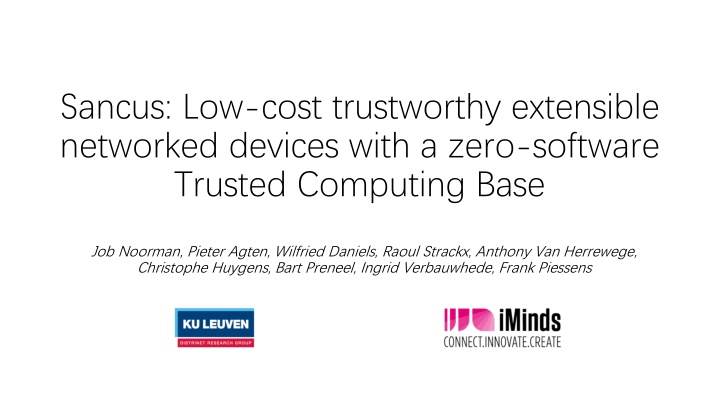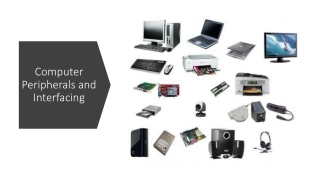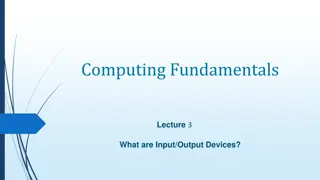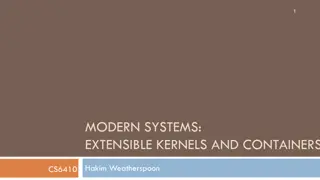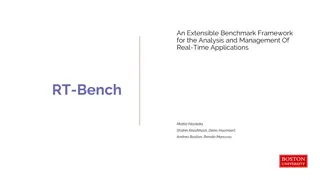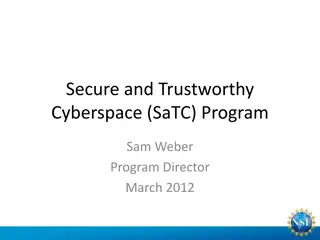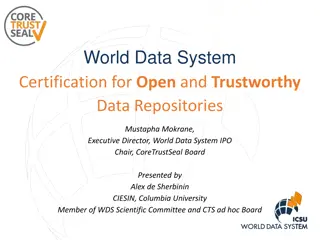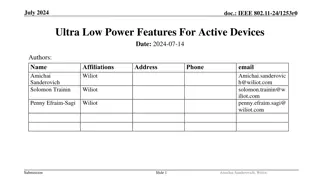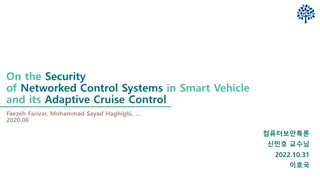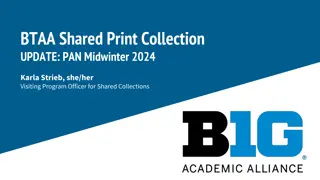Sancus: Low-cost Trustworthy Extensible Networked Devices
Sancus proposes a security architecture for resource-constrained embedded systems, addressing the lack of effective security features in low-end devices. It focuses on software module isolation, remote attestation, secure communication, and secure linking.
Download Presentation

Please find below an Image/Link to download the presentation.
The content on the website is provided AS IS for your information and personal use only. It may not be sold, licensed, or shared on other websites without obtaining consent from the author.If you encounter any issues during the download, it is possible that the publisher has removed the file from their server.
You are allowed to download the files provided on this website for personal or commercial use, subject to the condition that they are used lawfully. All files are the property of their respective owners.
The content on the website is provided AS IS for your information and personal use only. It may not be sold, licensed, or shared on other websites without obtaining consent from the author.
E N D
Presentation Transcript
Sancus: Low-cost trustworthy extensible networked devices with a zero-software Trusted Computing Base Job Noorman, Pieter Agten, Wilfried Daniels, Raoul Strackx, Anthony Van Herrewege, Christophe Huygens, Bart Preneel, Ingrid Verbauwhede, Frank Piessens
Low-end devices lack effective security features More threats on embedded devices Due to network connectivity and third-party extensibility No effective solutions exist It s a mess (Viega and Thompson) Researchers are exploring this area E.g., SMART (El Defrawy et al.)
Contributions We propose Sancus, a security architecture for resource- constrained, extensible networked embedded systems We implement the hardware required for Sancus as an extension of a mainstream microprocessor, and we show that the cost of these hardware changes (in terms of performance, area and power) is small. We implement a C compiler that targets Sancus enabled devices.
Problem statement Design and implement a low-cost, extensible security architecture System model Attacker model Security properties
System model Infrastructure provider, IP Nodes Ni Software modules SMj,k In this paper, we focus on the low-end of this spectrum, where nodes contain only a small embedded processor.
Attacker model We assume attackers can manipulate all the software on the nodes. Attackers can also tamper with the operating or even install a completely new operating system We assume attackers can control the communication network. Attackers can sniff the network, can modify traffic, or can mount man-in-the-middle attacks. Attacks against the hardware are out of scope. We assume the attacker does not have physical access to the hardware
Security properties Software module isolation. Remote attestation Secure communication Secure linking.
Design of Sancus Modules isolation Key management Remote attestation and secure communication Secure linking
Modules isolation (Memory protection on the nodes) Variable access rights Depending on the current program counter Isolation of data Only accessible from text section Protection against code misuse (e.g., ROP) Enter module through single entry point
Key management (Providing a flexible, inexpensive way for secure communication) Establish a shared secret Between SP and its module SM Use symmetric crypto Public-key is too expensive for low-cost nodes Ability to deploy modules without IP intervening
key derivation function kdf Key management (Providing a flexible, inexpensive way for secure communication)
Remote attestation and secure communication (Ability to use KN,SP,SM proves the integrity and isolation of SM) Only N and SP can calculate KN,SP,SM N knows KN and SP knows KSP KN,SP,SM is calculated after enabling isolation No isolation, no key; no integrity, wrong key Only SM on N is allowed to use KN,SP,SM Enforced through special instructions
Remote attestation and secure communication (Ability to use KN,SP,SM proves the integrity and isolation of SM) Integrity and isolation attested by MAC, liveliness by nonce Thus included in secure communication MAC Message Authentication Code
Secure linking (Modules are verified by calculating a MAC over their identity) A is deployed with a MAC of B s identity using A s key In an unprotected section since it is unforgeable A calculates the MAC of B s actual identity If they match B can safely be called Done through new instruction: mac-verify Need ensurance on B s isolation Module A wants to call module B
